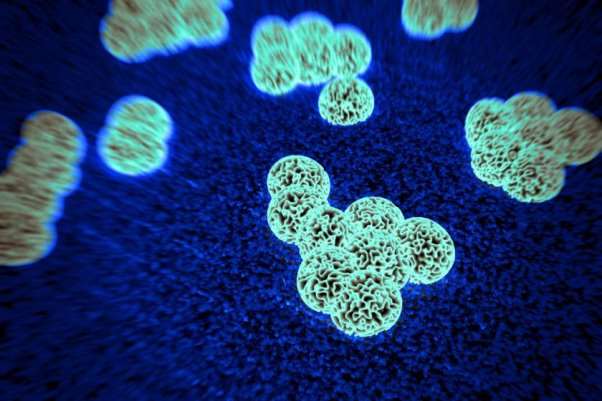Table of Contents Discovery and development of antibiotics-tetracycline Introduction Tetracyclines The discovery Development of antibiotics Discovery of tetracycline Safety and environmental issues of the production and the product itself Potential problems with antibiotics-tetracycline Scope for improvement and future of antibiotics Conclusion References |
Discovery and development of antibiotics-tetracycline
Introduction
An antibiotic is a single or a group of substances normally obtained from micro-organisms that block the development of a certain different micro-organisms or even destroy them. They are obtained from extraordinary microorganisms or other living frameworks, and are delivered by a modern method utilizing an ageing process. In spite of the fact that the standards of antibiotic activity were not found until the twentieth century, the first known utilization of antibiotic was from the Chinese more than 2,500 years back. Today, more than 10,000 anti-microbial substances have been accounted for. Right now, antibiotics are a billion dollar industry that keeps on growing every year.The variety of antibiotics presently available can be grouped by different methods like the chemical structure they are made of, the micro-organisms from which they are obtained, or the action they perform. They can also be designated by their range of action, e.g., Tetracycline, cephalosporin, polymixin etc.
Tetracyclines
It is a wide range polyketide antibiotic derived by the Streptomyces sort of Actinobacteria. [5]This is used against numerous bacterial diseases. It is a protein amalgamation inhibitor and is usually used to treat skin inflammation, rosacea, urinary tract infections and is truly imperative in decreasing the number of deaths from cholera. The term “tetracycline” is additionally used to indicate the four-ring arrangement of this compound; “tetracyclines” are connected substances that contain the same four-ring framework.

http://www.explorecuriocity.org/portals/2/Symposia/Antibiotics/_2993.jpg

http://cdni.wired.co.uk/1920×1280/a_c/antibiotics.jpg
The discovery
In spite of the fact that for a considerable length of time preparations derived from living organisms were applied to wounds to eradicate or remove diseases or ailments, the way that a microorganism is equipped for destroying one of other animal types was not proved until the last of the 19th century.
The tetracycline, an expansive group of anti-infective agents, was founded as an ordinary item by Benjamin Minge Duggar in 1945 and initially endorsed in 1948.Under Yellapragada Subbarow, Benjamin Duggar made his discovery of the first tetracycline antibiotic- chlortetracycline (Aureomycin), at Lederle Laboratories in 1945. [9]
In 1950, Harvard University teacher Robert Burns Woodward decided the compound structure of the related substance, Oxytetracycline (Terramycin); the patent security for its fermentation and generation was additionally initially issued in 1950. [8]An examination group of eight researchers (K.J. Burnings, Francis A. Hochstein, Frederick J. Pioneer C.R. Stephens, Lloyd Hillyard Conover, Abraham Bavley, Richard Pasternack, and Peter P. Regna) at Pfizeras ,a team with Woodward, took an interest in the two-year examination prompting the discovery.

http://thescienceofacne.com/wp-content/uploads/Tetracycline-Sumycin-Molecule-640×404.jpg?a355a6
Development of antibiotics
Antibiotics are made in the industry by a procedure of fermentation, where the source microorganism is developed in substantial holders (100,000 – 150,000 liters or additionally) containing a fluid development medium. The concentration of oxygen, degree of temperature, pH of the medium, and supplement levels must be idealistic and are closely observed and balanced if important. As antibiotics are optional metabolites, the population size must be controlled deliberately to guarantee that most extreme yield is acquired before the cells dies. When the procedure is finished, the antibiotic must be removed and decontaminated to a crystalline item.This is less difficult to accomplish if the antibiotic is dissolved in natural solvent. Else, it should first be uprooted by ion exchange, adsorbed, or precipitated on a chemical.
Discovery of tetracycline
Chlortetracycline and Oxytetracycline, both found in the late 1940s, were the first members from the tetracycline group to be portrayed.[4]These particles were results of Streptomyces aureofaciens and S. rimosus, individually. Different tetracyclines were distinguished later, either as characteristically happening atoms, e.g., tetracycline from S. aureofaciens, S. rimosus, and S. viridofaciens and demethylchlortetracycline from S. aureofaciens, or as results of semisynthetic methodologies, e.g., methacycline, doxycycline, and minocycline. In spite of the achievement of the early tetracyclines, analogs were looking for with an enhanced water solubility either to permit parenteral organization or to improve oral assimilation. These methodologies brought about the advancement of the semisynthetic mixes rolitetracycline and lymecycline. The most of late found tetracyclines are the semisynthetic collections alluded to as glycylcyclines, e.g., 9-(N, N-dimethylglycylamido) -6-demethyl-6-deoxytetracycline, 9-(N, N-dimethylglycylamido) -minocycline, and 9-t-(butylglycylamido) -minocycline.[12] These mixes have a 9-glycylamido substitution. .[11] The 9-t-butylglycylamido subordinate of minocycline (tigilcycline; once known as GAR-936) started stage- I in October 1999 and is as of now experiencing stage- II clinical trials. A portion of the prior mixes, e.g., clomocycline, are no more showcased, and others, e.g., rolitetracycline, lymecycline, and chlortetracycline, are not accessed.

http://openi.nlm.nih.gov/imgs/512/272/2823312/2823312_ORT-1745-3674-80-693-g003.png

http://dailysciencejournal.com/wp-content/uploads/2015/01/bug.jpg
Safety and environmental issues of the production and the product itself
The large scale manufacturing of antibiotics started amidst World War II with streptomycin and penicillin. Presently, most antimicrobial agents are delivered by organized ageing. In this, strains of microorganisms delivering significant benefits are developed under ideal conditions in supplement media in aging tanks holding a few thousand gallons. The mold is strained out of the maturation soup, and afterward the antibiotic is expelled from the stock by filtration, precipitation, and other detachment systems. At times new antimicrobials are lab blended, while numerous antibiotics are created by artificially adjusting regular substances; numerous such subordinates are more powerful than the characteristic substances against contaminating creatures or are better consumed by the body.
Potential problems with antibiotics-tetracycline
Antibiotics are either infused, given orally, or applied to the skin. A number of them, while strong against infective agents, additionally cause lethal symptoms. Some, similar to penicillin, are exceedingly allergenic and can bring about skin allergies, shock, and different types of sensitivity to allergens.Others, for example, the tetracycline, bring about real changes in the intestinal bacterial and can bring about super infection by parasites and different microorganisms.[3,10]
Tetracyclines ought to be utilized with caution in patients with liver weakness.[10]Those tetracyclines that are soluble in water and urine intensify renal failure (this is not valid for the lipid dissolvable operators doxycycline and minocycline). They may expand muscle weakness in myasthenia Gravis and compound systemic lupus erythematosus. [3]
Quality control is of most significance in the generation of antibiotics. Since it includes a fermentation procedure, steps must be taken to guarantee that truly no defilement is presented anytime amid generation. At this end, the medium and the greater part of the equipment are completely steam cleaned. Amid manufacturing, the rule for the end product of antibiotics is to look out for a normalancy every now and then.Of specific significance are successive checks of the state of the antimicrobial culture during fermenting. These are done using different chromatography strategies. Additionally, different physical and chemical properties of the completed item are checked, for example, pH, liquefying point, and dampness content.
.

https://explorable.com/images/antibiotics.jpg

http://www.onlineclinic.net/images/blog/injectable-l.jpg
Scope for improvement and future of antibiotics
Since the development of a new medicine is a costly affair, pharmaceutical organizations have done almost no research in the most recent decade. Notwithstanding, a disturbing improvement has prodded a restored enthusiasm for the advancement of new antibiotics.[7] It just so happens, a part of the ailment causing microorganisms has altered and built up resistance to a large number of the standard antibiotics, including tetracyclines.[6] This could have grave outcomes on the world’s general wellbeing unless new antibiotics are found or enhancements are made on the ones that are accessible. This testing issue will be the center of exploration for a long time to come.
Researchers are attempting to develop new methodologies to battle the developmental risk of micro-organisms that present antibiotics like tetracyclines can’t battle. A few specialists are trying new substances; for example, silver, to consolidate with antibiotics to support their killing force.[2] Different scientists are making the utilization of hereditary sequencing of microbes to help create medications at a quicker pace than medical science was equipped for previously.
Another system expects to render destructive microorganisms unequipped for contaminating individuals, as opposed to killing the micro-organisms through and through. One such procedure would kill infection, bringing about poisons by disturbing the microscopic organisms’ interior components.
Conclusion
Antibiotics, including tetracyclines have a limited lifetime in light of the fact that resistance is inevitable, therefore, there’s dependably a need to innovate.[1] Bacteria have methods for shielding themselves against other microorganisms, and most antibiotics are obtained from the poisons they utilize. Distinguishing and growing new antibiotics is a long and moderate process. Whether the antibiotic will be valuable in treating individuals stays to be seen. The principle issue with recognizing new antibiotics isn’t that they don’t work. They work and yet they cause serious symptoms or danger.
References
- Antibiotic Development: the Battle to Overcome Antibiotic Resistance. (1984).
Inpharma
,
437
(1), 4-4. - Averting the antibiotics apocalypse now. (2013).
New Scientist
,
217
(2908), 3. - Bevelander, G. (1963). Effects of Tetracycline.
BMJ
,
1
(5322), 54-54. - Chlortetracycline. (1999).
Reactions Weekly
,
&NA
(773), 7-8. - Filippova, S., Surgucheva, N., & Gal’chenko, V. (2012). Long-term storage of collection cultures of actinobacteria.
Microbiology
,
81
(5), 630-637. - Litman, J. Antibiotic Resistance.
SSRN Journal
. - NEW ANTIBIOTICS. (1976).
Inpharma
,
45
(1), 12-12. - Oxytetracycline (terramycin). (1955).
Tubercle
,
36
(3), 92. - TETRACYCLINE. (1954).
The Lancet
,
263
(6813), 664. - Tetracycline Hepatotoxicity. (1964).
BMJ
,
2
(5424), 1545-1546. - Tetracycline see Doxcycline/tetracycline. (1988).
Reactions
,
224
(1), 8-8. - Tetracyclines from Scratch. (2005).
Science
,
308
(5720), 321e-321e.
PLACE THIS ORDER OR A SIMILAR ORDER WITH NURSING TERM PAPERS TODAY AND GET AN AMAZING DISCOUNT






